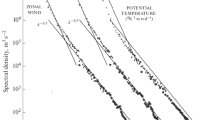Abstract
In general, the multifractal model provides more information about measurements on spatial objects than a fractal model. It also results in mathematical equations for the covariance function and semivariogram in spatial statistics which are determined primarily by the second-order mass exponent. However, these equations can be approximated by power-law relations which are comparable directly to equations based on fractal modeling. The multifractal approach is used to describe the underlying spatial structure of De Wijs 's example of zinc values from a sphalerite-bearing quartz vein near Pulacayo, Bolivia. It is shown that these data are multifractal instead of fractal, and that the second-order mass exponent (=0.979±0.011 for the example) can be used in spatial statistical analysis.
Similar content being viewed by others
References
Agterberg, F. P., 1994, Fractals, multifractals, and change of support,in Dimitrakopoulus, R., ed., Geostatistics for the next century: Kluwer. Dordrecht, p. 223–234.
Agterberg, F. P., Cheng, Q., and Wright, D. F., 1993, Fractal modeling of mineral deposits,in Elbrond, J., and Tang, X., eds., Application of computers and operations research in the mineral industry: Proc. 24th APCOM Symposium, v. 1, Can. Inst. Mining, Metallurgy and Petroleum Eng. (Montreal), p. 43–53.
Bartlett, M. S., 1966, An introduction to stochastic processes (2nd ed.): Cambridge Univ. Press, Cambridge, 362 p.
Billingsley, P., 1986, Probability and measure (2nd ed.): John Wiley & Sons, New York, 622 p.
Cheng, Q., 1994, Multifractal modeling and spatial analysis with GIS: Gold potential estimation in the Mitchell-Sulphurets area, northwestern British Columbia: unpubl. doctoral dissertation, Univ. Ottawa, Ottawa, 268 p.
Cheng, Q., and Agterberg, F. P., 1995, Multifractal modeling and spatial point processes: Math. Geology, v. 27, no. 7, p. 831–845.
Cheng, Q., Agterberg, F. P., and Ballantyne, S. B., 1994, The separation of geochemical anomalies from background by fractal methods: Jour. Geochemical Exploration, v. 51, no. 2, p. 109–130.
Csörgö, M., and Révész, P., 1981, Strong approximations in probability and statistics: Academic Press, New York, 284 p.
De Wijs, H. J., 1951, Statistics of ore distribution: Geologie en Mijnbouw, v. 13, no. 8, p. 365–375.
Evertsz, C. J. G., and Mandelbrot, B. B., 1992, Multifractal measures,in Peitgen, H.-O., Jürgens, H., and Saupe, D., eds., Chaos and fractals: Springer Verlag, New York, p. 922–953.
Fairfield-Smith, H., 1938, An empirical law describing heterogeneity in the yields of agricultural crops: Jour. Agricultural Sci., v. 28, no. 1, p. 1–23.
Feder, J., 1988, Fractals: Plenum, New York. 283 p.
Hentschel, H. G. E., and Procaccia, I., 1983, The infinite number of generalized dimensions of fractals and strange attractors: Physica, v. 8, pt. D, p. 435–444.
Mandelbrot, B. B., 1983, The fractal geometry of nature (updated and augmented edition): W.H. Freeman and Company, New York, 468 p.
Mandelbrot, B. B., and Evertsz, C. J. G., 1991, Exactly self-similar left-sided multifractals,in Bunde, A., and Havlin, S., eds., Fractals and disordered systems: Springer Verlag, Heidelberg, p. 323–344.
Mandelbrot, B. B., and Van Ness, J. W., 1968, Fractional brownian motions, fractional noises and applications: SIAM Review, v. 10, no. 4, p. 422–437.
Matheron, G., 1962, Traité de Géostatistique Appliquée. Mém. Bur. Rech. Géol. Minières, v. 14, p. 1–333.
Meneveau, C. and Sreenivasan, K. R., 1987, Simple multifractal cascade model for fully developed turbulence: Phys. Review Letters, v. 59, no. 13, p. 1424–1427.
Rose, C. D., 1983, Variances in sampling streams of coal: Jour. Testing and Evaluation, v. 11, p. 320–330.
Rose, C. D., 1992, A fractal model for sampling coal, ores, and other natural populations: Jour. Coal Quality, v. 11, no. 1–2, p. 6–13.
Stanley, H. E., and Meakin, P., 1988, Multifractal phenomena in physics and chemistry: Nature, v. 335, no. 6189, p. 405–409.
Taqqu, M. S., 1988,in Kotz, S., and Johnson, N., eds., Self-similar processes: Ency. of Stat. Sci., v. 8: John Wiley & Sons, New York, p. 352–357.
Yaglom, A. M., 1966, The influence of fluctuations in energy dissipation on the shape of turbulence characteristics in the inertial interval: Soviet Physics-Doklady, v. 11, p. 26–29.
Author information
Authors and Affiliations
Rights and permissions
About this article
Cite this article
Cheng, Q., Agterberg, F.P. Multifractal modeling and spatial statistics. Math Geol 28, 1–16 (1996). https://doi.org/10.1007/BF02273520
Received:
Accepted:
Issue Date:
DOI: https://doi.org/10.1007/BF02273520




